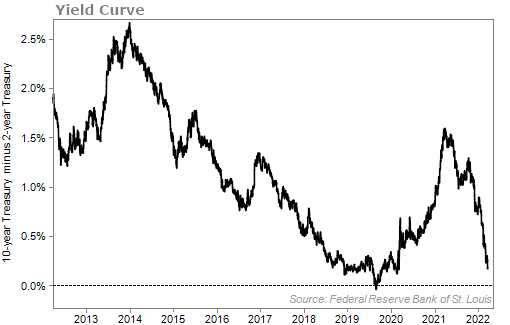As investors, we've had to endure a lot over the past few months...
There's inflation at 40-year highs. There's a war in Ukraine. There's a severe bear market in tech stocks... And now, the "yield curve" is close to inverting, signaling that a recession may be near.
It's been a lot to process. And given everything happening, it makes sense that the S&P 500 Index entered into a correction.
But the question remains... What else could go wrong?
Sure, we could see 1970s-like inflation. But it's unlikely. And it's unlikely that World War III is around the corner.
All of the terrible things that are happening today are already priced into the market. Every investor is aware of them. And any progress in solving any one of them could send markets soaring.
While many investors are overwhelmed by all of the issues the stock market is facing, I (Jeff Havenstein) tend to be more optimistic.
A lot of folks are sitting on the sidelines right now with their portfolios in cash because of all the risks I mentioned.
According to a monthly survey of global fund managers by Bank of America, fund managers have recently increased their cash positions to the highest since April 2020 – the early COVID-19 pandemic days. And if you remember back to April 2020, that was the ultimate time to buy, as stocks had already bottomed.
Many investors are simply waiting for some magical signal before they commit to dumping more money into the market.
This buy signal could be an inflation number that is less than expected. It could be a cease-fire – or really any progress to the Russia-Ukraine conflict. Or it could be a rally in beaten-down tech stocks.
Since investors have a lot of dry powder, when it's finally put to use, markets can head much higher.
Also, another thing to look at is market sentiment. There are very few bulls in the market today.
Bank of America's most recent Bull & Bear Indicator – which measures investor sentiment – was at 2.3 in its most recent reading (out of a possible 10). That's down from 2.9 in the prior week.
This shows that investors remain extremely cautious on the markets... which as a contrarian, is a bullish sign.
One thing I want to focus on for the rest of the day is the yield curve... It's been all over the news lately.
The yield curve is the difference between long-term interest rates and short-term interest rates. Typically, long-term rates are greater than short-term rates because investors demand to be paid more for locking their money away for a decade or more. There's more risk with the longer duration.
Lately, there's been a bit of panic because of the "flattening" of the yield curve. This means that the gap between long-term yields and short-term yields is shrinking. Take a look...

The accuracy of the yield curve as a recession predictor is hard to argue with. Every recession in the past 60 years was preceded by an inverted yield curve.
Over the past six decades, there was only one false positive. In the mid-1960s, the curve inverted, which was followed by an economic slowdown but not an official recession.
But one thing I want to stress is that once the yield curve inverts, the economy doesn't automatically enter a recession. It can happen in as little as 6 months or up to two years.
That means even if the yield curve does invert, there's still plenty of time for markets to rally... And that is what I expect.
Put simply, there's a lot that's going wrong at the moment. But once there is progress on any one of the issues, you want to be long the market.
I have been a buyer during this correction and still am today.
What We're Reading...
- An inverted yield curve is likely after the Fed raised interest rates.
- Zelensky says Ukraine is ready to discuss deal for Russian cease-fire.
- Something different: 'Living in a frightening situation'- Estonian women learn to fight.
Here's to our health, wealth, and a great retirement,
Jeff Havenstein with Dr. David Eifrig
March 23, 2022
